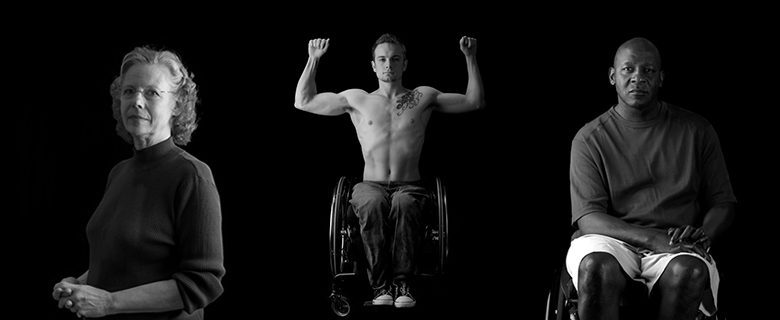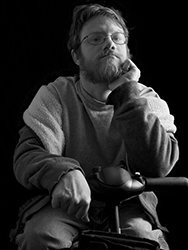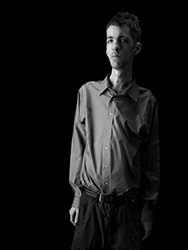
Challenging impaired perceptions of disability
Do you have an impaired perception?
I know what you’re thinking; that was a ridiculous opening sentence. How could this weird internet person know what I am thinking? He has never even met me, much less read my Hello Kitty diary, so the idea that he could know my thoughts without knowing me is simply preposterous.
Well, I couldn’t agree more. No, I am not advocating reading other people’s diaries. But I do contend that you cannot know what someone is thinking or what they are capable of simply by looking at them.
In fact, I have been working on an ongoing photography project based on that very concept. My name is Brian Charles Steel and I am a fine art photographer in the US. My latest project is aimed at empowering people with physical impairments, and changing the way that we are perceived.
 Entitled Impaired Perceptions, and it is a series of black and white photographic portraits of people with various physical impairments. So far the work has resonated with a lot of people’s lives – when the series was featured on CNN.com lots of people wrote about their own experiences and people that they knew.
Entitled Impaired Perceptions, and it is a series of black and white photographic portraits of people with various physical impairments. So far the work has resonated with a lot of people’s lives – when the series was featured on CNN.com lots of people wrote about their own experiences and people that they knew.
The title is a play on words; the people in the photographs have various physical impairments, but it is the perceptions that some have of them, because of their conditions, that is fundamentally impaired.
To make the portraits cohesive and free from distractions, I shot each portrait vertically with a solid black backdrop. In each of the portraits, the person looks directly into the camera; I use direct eye contact to aid the viewer in identifying with the person.
I also use tenebrism – a technique originating from Baroque painting that uses a sharp light and dark contrast to draw the eye to the point of focus – to draw the viewer’s eye to the subject. My goal is to empower each participant, and to aid the viewer in seeing each person as an individual.
Some of the participants of Impaired Perceptions have visibly noticeable physical impairments. For example, I was born with Congenital Fiber Type Disproportion (CFTD). CFTD is a condition where mutations in the genes produce proteins responsible for muscle tensing, causing impaired muscle contraction, resulting in less muscle tissue and muscle weakness in the skeletal muscles.
Skeletal muscles are responsible for holding our body in place giving us our physical form, so you can imagine how weakness in the skeletal muscles can impact one’s appearance. Physical differences, like mine, have caused people to draw false conclusions. When you have a physical impairment like CFTD or cerebral palsy, people sometimes assume that you are helpless, and mentally impaired. These assumptions stem from a form of discrimination called ableism.
Ableism is a form of discrimination against people with impairments where the impaired person is treated as though they are broken or need to be fixed in order to function in society. People will sometimes assume that you must have someone taking care of you, or that you can’t drive. The most common one is assuming that you as a physically impaired person need help with the simplest things, such as opening a door.
Basically, people tend to assume you left your home that day with no real plan for handling day-to-day life. Don’t get me wrong, it is nice to know that strangers care enough to take time to lend a hand to a fellow human being. But the assumptions behind those gestures can be harmful.
The best thing to do in those circumstances is to first watch and observe. If the person seems to be handling everything fine, then there is no need to offer assistance. But if the person is struggling, then you might offer to help as you would for anyone.
Some of the people I met through this project have impairments that are not visible. They are on the opposite end of the misperception spectrum – they appear perfectly able, so people don’t understand why they have trouble doing certain things.
 I photographed a woman named Carolyn who battles with from chronic fatigue syndrome. She looks and seems perfectly healthy on some days, but on others she can’t get out of bed. This is not to say that she doesn’t live a fulfilling life, but there are times when she feels like people don’t understand why she is unable to do certain things.
I photographed a woman named Carolyn who battles with from chronic fatigue syndrome. She looks and seems perfectly healthy on some days, but on others she can’t get out of bed. This is not to say that she doesn’t live a fulfilling life, but there are times when she feels like people don’t understand why she is unable to do certain things.
The point is that you cannot know what someone is capable of or what their life is like by simply looking at them. I photographed a gentleman named Curtis Lovejoy who was born with an able body, but sustained a spinal cord injury while he was in his twenties. The injury left him quadriplegic, and a therapist told him he had reached his full potential, that he would never have use of his body again.
Lovejoy is now a Paralympic athlete with ten world records in swimming and fencing. I am not mentioning this to vilify therapists or physicians; a lot of them have helped their patients do amazing things. I am using this story to illustrate that you cannot know what someone is capable of without knowing what is in his or her heart.
A lot of times in the discussion of disability there is a lot of talk about awareness, and it is certainly better than ignorance. But knowing about the condition that someone was diagnosed with does not equate to knowing that person or what their life is like. The effects of a condition vary in severity from person to person, and people handle things in different ways. So no matter how much we think we know about a condition, we need to individualise with each person. That is what Impaired Perceptions is all about – seeing people as individuals.
In June I will be presenting the work to NASA, and I am currently organising a traveling exhibition where I will show the series at colleges and universities, and talk about the meaning behind the photographs.
Visit Brian’s website to see more images from his Impaired Perceptions project.
By Brian C. Steel
Check out…
• Q&A with Jack Eyers
• Photography: capturing life and the world we live in
• Q&A with On the Move photography competition winner
Get in touch by messaging us on Facebook, tweeting us @DHorizons, emailing us at editor@disabilityhorizons.com or leaving your comments below.
Well done Brian, it’s like saying in the dark because people don’t like to see the light